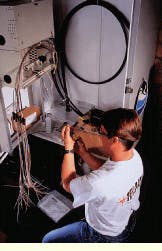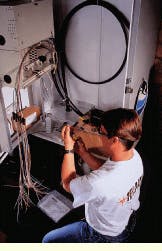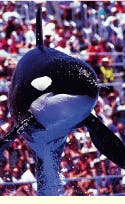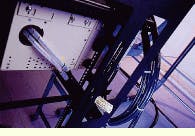Fiber-optic network makes a splash at Sea World
Theme-park cable installation spans several indoor and outdoor environments using indoor/outdoor cable.
Sally Smith Crocker
Siecor Corp.
Until three years ago, Sea World (San Diego, CA) used a copper-based system for its communications needs. But problems such as electromagnetic interference from the automated teller machines at the park caused the old copper system to malfunction frequently--and when the park`s pass system failed, visitors were inconvenienced.
"Because Sea World is a large park, we were having troubles with communication to areas that we needed to reach through existing copper telecommunications wiring," says Greg Webb, assistant manager of information technology at Sea World. "We needed a system that would grow with the speed of data communications and support future plans for the security, audio, and video systems. We wanted to make an installation that was useful for many things, and fiber was the choice."
Fiber optics was needed to support the entertainment efforts at Sea World because fiber allows for full-motion video and high-quality sound, computer graphics, and telephone conversations--all over one pair of optical fibers. The large information-carrying capacity ensures a network that will provide a long service life.
Also, because optical signals are used, all-dielectric cables that are much less susceptible to electrical surges--even if the cables are struck directly by lightning--can be used. Fiber-optic cables also provide electromagnetic compatibility, so it is possible to route them near noise inducers such as electrical motors and fluorescent lights. The small size and light weight of optical-fiber cables give system designers added flexibility. And, fiber systems provide a secure communications medium--it is not possible to "tap" an optical fiber without being detected easily.
Therefore, Sea World has been replacing its copper system with fiber-optic cables. To date, the installation includes nearly 40,000 feet of loose-tube fiber-optic cable and approximately 5000 feet of tight-buffer fiber-optic cable. The Sea World network has been designed for easy system management, with cables running from a computer center to different locations throughout the park--the Skytower, Penguin Encounter, gift shops, Shamu Stadium, employee store, security, and public relations offices.
Installation environments
Meeting the diverse requirements for a structured cabling system presented Sea World, installation contractor Teldata Voice & Data Communications (San Diego, CA), and major manufacturing supplier Siecor Corp. (Hickory, NC) with several challenges. For instance, an important issue was Sea World`s close integration of indoor and outdoor settings. The established practices and topology of structured cabling, however, enabled those involved in the installation to segregate the different requirements of the outdoor environment from those of the indoor environment and provide a solution that addressed both.
Primarily designed for Sea World`s current data communications applications, the fiber-based backbone system is used to track point-of-sale for the park`s stores, assist in materials management, secure the park entrance and exit, and support administrative systems. It includes several points of distribution, beginning with one main computer room from which the fiber-optic cable is distributed, to other key locations such as exhibits and stores.
During the installation, both outdoor and indoor environments were factors in the choice of the backbone cable design. Although severe weather is not an important concern in southern California, some outdoor environments subject a cable to an extreme range of environmental factors, including a wide operating- temperature range, thermal shock, wind loading, ice loading, rain, snow, flood-ing, and lightning. Therefore, protecting and preserving the fiber was a priority in the design.
For the cable manufacturer, the challenge was to find the best design to meet the optical performance and building-code requirements, while providing a user-friendly cable at the most affordable cost. Siecor`s focus centered on loose-tube and tight-buffer cables to meet the demands of the premises environment.
In general, campus-backbone links are the longest cables in a network. Also, they typically have the highest fiber counts in the system, which means that outdoor cables are the most costly. Therefore, minimizing the cost of the backbone cable is especially important. Campus-backbone outdoor cables are not subject to building codes unless they enter a building. Therefore, the long deployment lengths require that the cable be robust enough to withstand significant pulling tension without damage during placement. Also, because of the high fiber counts, easy sheath removal and fiber access for termination and cable-segment splicing are desirable.
These requirements are best met with loose-tube cable. Fibers are placed in gel-filled buffer tubes, isolating them from outside forces. No other design has been used more extensively in the cabling industry; with more than 18 years of successful operation in the field, the loose-tube design provides stable, robust protection during installation and maximum performance and longevity by isolating the fibers from stress.
Three basic types of outside-plant installation in the outdoor environment include duct, direct-burial, and aerial. The cable must endure different conditions in each type of installation. Yet, if designed correctly, the same loose-tube cable core can be used for all these environments.
Fortunately, the indoor environment is usually much less hostile to the cable. It is not subject to wide temperature ranges, wind, or ice loading, and is rarely exposed to moisture. While the cable still needs to protect and preserve the fiber, the absence of these environmental extremes makes this much easier to do, while focusing on other design criteria.
Indoor-cable links are relatively short, and because of this, cable design is biased more toward fiber handling and termination. So, optimizing the ease and speed of sheath entry, cable preparation and fiber access become more important in reducing the total installed-cable cost. Also, the most critical design parameter of an indoor cable is its flame-retardant feature.
Tight-buffer cables are desirable because of their increased physical flexibility, smaller bend radius, easier handling in low fiber counts, and ability to meet fire-code requirements. To provide strength, tight-buffer cables are reinforced with aramid yarns. Just as with loose-tube cables, the yarns relieve any fiber strain during installation and provide protection during long-term operation.
Installation challenges
At Sea World, several challenges had to be met during installation, including the problem of limited space. Doug Catania, president of Teldata, says this obstacle was overcome in part by using wall-mounted racks and cabinets, which accommodated fiber-optic enclosures and other distribution products.
A bigger concern was the amount of conduit fill in the existing underground conduit system. Although it was not easy to construct new trenches exclusively for the fiber-optic conduits, Teldata worked closely with Sea World`s management information system and technical services departments to complete the construction.
During the design phase of the new Shamu Backstage exhibit, the construction crews accidentally penetrated the loose-tube fiber-optic cable with an auger bit. Teldata was able to reroute the cable and restore the cut fiber cable with a mechanical splice. This temporary fix lasted a year without any degradation of the system, proving that mechanical splices could withstand the elements.
A technician of Teldata Voice & Data Communications (San Diego, CA) attaches connectors to optical fibers at the San Diego Sea World installation.
Today, marine mammals perform before large audiences at Sea World. In the future, when the theme park installs videoconferencing equipment, they will also be able to communicate long-distance with each other
Cable-dressing is an important part of maintaining fiber-optic cable`s minimum bend radius and adhering to its tensile-loading limits. Here cable bundles enter the rear of a distribution frame at Sea World.
A Look at Fiber-optic Components
The Sea World (San Diego, CA) fiber-optic system uses loose-tube cable with 62.5/125-micron multimode optical fiber, the industry-standard fiber size for campus applications. Fiber counts range from 6 to 96 fibers, depending on capacity needs and anticipated future requirements. At Sea World, dielectric cable was installed in underground conduits running between buildings.
Because the installation had to take place after hours so as not to disturb park visitors, Teldata installers worked the graveyard shift during the summer, making sure the system was up and running when employees reported to work the next morning.
Sea World did not terminate all fiber strands during installation, in order to save on the labor of installing termination racks, according to Doug Catania, president of installation contractor Teldata Voice & Data Communications (San Diego). Catania says that leaving fibers unterminated in this way is an acceptable cabling practice.
"Even though it`s not essential to terminate every fiber strand in the buffer tube during the installation, it is essential to fan out each buffer tube," Catania adds. "When the technician goes back to terminate these fibers, the fan-out will be easier in terms of fiber identification and installation time."
Because optical fiber is easy to handle and manage, the technical staff at Sea World will handle the day-to-day network administration. "They have documentation that`s easy to follow," Catania says. "They will patch fibers in as needed."
Sally Smith Crocker is an industry relations specialist at Siecor Corp. (Hickory, NC).



